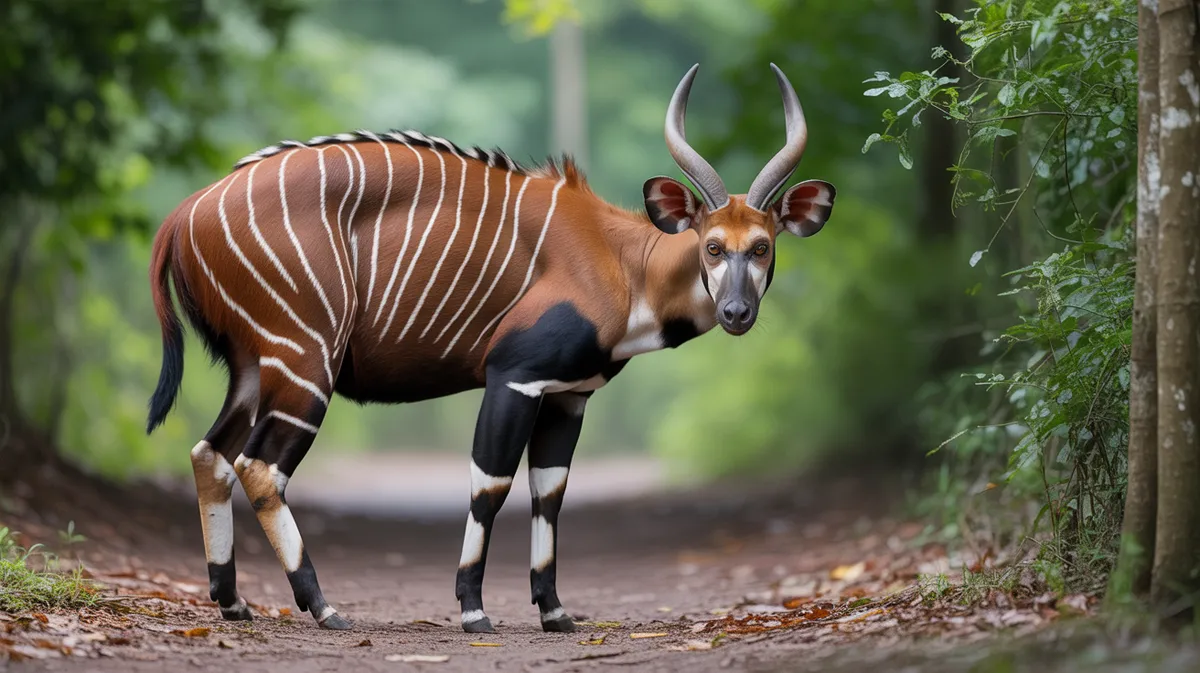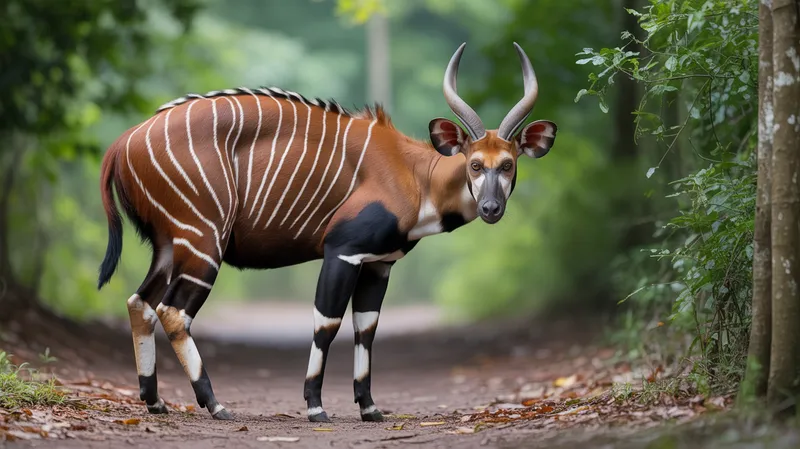
Bongo
Tragelaphus eurycerus

Meet the Bongo
The bongo is a large, strikingly patterned antelope native to the dense forests of central and western Africa. It is easily recognized by its rich chestnut coat marked with vivid white stripes and long, spiraled horns present in both males and females. Bongos are shy, mostly nocturnal animals that prefer the concealment of thick vegetation and are rarely seen in the open. They play an important role in their ecosystem by aiding in seed dispersal through their browsing habits. Bongos are threatened by habitat loss and hunting, making them increasingly rare in the wild.
Classification
Mammal
Habitat
Dense forest
Diet
Herbivore
Lifespan
10-20 years
Conservation
Near Threatened
Weight
150-405 kg
📖Fascinating Facts
Forest Dweller
Bongos are primarily found in dense, montane and lowland forests, where their coloration provides effective camouflage.
Both Sexes Horned
Unlike most antelopes, both male and female bongos sport long, spiraled horns, which can grow up to a meter in length.
Nocturnal and Elusive
Bongos are mainly nocturnal and crepuscular, feeding at night and dusk to avoid predators and human disturbance.
📋Detailed Description
The bongo (Tragelaphus eurycerus) is the largest and heaviest forest antelope, with adult males weighing between 220–405 kg (485–893 lbs) and females 150–235 kg (330–518 lbs). Standing 1.1–1.3 meters (3.6–4.3 ft) at the shoulder, bongos are characterized by a deep chestnut coat adorned with 10–15 vertical white stripes, which serve as camouflage in dappled forest light. Both sexes possess long, slightly spiraled horns, with males' horns reaching up to 99 cm (39 in) and females' slightly shorter. Their large, mobile ears provide acute hearing, while a prehensile upper lip aids in selective browsing. Bongos are primarily crepuscular and nocturnal, emerging at dusk and dawn to feed. They are highly secretive and rely on dense cover for protection, rarely venturing into open spaces. Socially, bongos form small groups (typically 2–8 individuals), usually composed of females and their offspring, while mature males are mostly solitary except during the breeding season. Their home ranges can overlap, but they avoid direct confrontation through scent marking and vocalizations. Bongos play a crucial ecological role as browsers, consuming a wide variety of leaves, shoots, vines, bark, and fruits, which aids in forest regeneration and seed dispersal.
💡 Did you know?
The Eastern or mountain bongo (T. e. isaaci) is one of the rarest large mammals in Africa, with fewer than 100 individuals left in the wild.
🔬Research & Sources
🎭Behavior & Social Structure
Bongos are elusive and shy, utilizing thick undergrowth for concealment and moving quietly through the forest. They are most active during twilight and nighttime hours, resting in dense thickets during the day. Feeding behavior involves selective browsing, using their prehensile lips and flexible tongues to grasp foliage, bark, and fallen fruit. They are known to dig with their horns for roots and mineral-rich soil, a behavior thought to supplement dietary minerals. Social interactions are generally peaceful, with group members communicating through low grunts, snorts, and foot stamping. Scent marking via preorbital glands and dung piles is common, especially among males, to establish territory and avoid direct conflict. When threatened, bongos may freeze or flee in zigzag patterns, using their stripes for camouflage. Predators include leopards, hyenas, and occasionally humans.
👶Reproduction & Life Cycle
Bongos breed year-round, though births peak at the end of the rainy season. Courtship involves males following and testing the receptivity of females through flehmen response and gentle nudging. After mating, the gestation period lasts approximately 285 days (9.5 months). Females give birth to a single calf, which is hidden in dense vegetation for the first 1–2 weeks of life. During this period, the mother visits the calf only to nurse, minimizing scent trails to avoid predation. Calves are weaned at 6 months and remain with the mother for up to a year. Sexual maturity is reached at 2–3 years for females and 3–4 years for males. Parental care is primarily maternal, with males playing no role in rearing offspring.
🛡️Adaptations & Survival
Bongos exhibit several adaptations for forest life: their rich coloration and vertical stripes provide disruptive camouflage in the filtered light of the understory. Their large, splayed hooves help them traverse soft, muddy ground, while their flexible bodies allow them to move swiftly through dense vegetation. The prehensile upper lip and long tongue enable selective feeding on a wide variety of plant material. Acute hearing and a keen sense of smell aid in predator detection. The horns, which are swept backward, allow movement through thickets without entanglement and are used in intraspecific competition. Behavioral adaptations include nocturnality and secretive habits to avoid predation and human disturbance.
📚Research Sources
🎨Cultural Significance
Bongos hold cultural importance in several Central and East African societies. In Kikuyu and other Kenyan traditions, the bongo is regarded as a symbol of the forest and is sometimes associated with spiritual beliefs. Its striking appearance has made it a subject of local folklore, often depicted as a mystical or elusive creature. In some regions, bongo horns are used in traditional ceremonies or as musical instruments. The animal's rarity and beauty have also made it a flagship species for forest conservation efforts in Africa.
🔬Recent Research & Discoveries
Recent research has focused on the genetic diversity of bongo populations, particularly the critically endangered mountain bongo, to inform captive breeding and reintroduction programs. Radio telemetry and camera trapping have improved understanding of bongo movement patterns, habitat use, and population densities. Studies on diet and mineral supplementation have highlighted the importance of natural salt licks and soil consumption. Ongoing research is investigating the impact of disease transmission from livestock and the effectiveness of community-based conservation initiatives. Conservation genetics has revealed low genetic diversity in isolated populations, emphasizing the need for managed gene flow.
🎥Wildlife Videos

Why the Bongo Is One of Nature's Most Elusive Antelopes
The bongo antelope is a true hidden gem of Africa's rainforests! With its striking chestnut coat and white stripes, it's often called the ...
The Story of Animals

INTERESTING FACTS about bongo | a large species of antelope that is found inhabiting the jungles
pet #animal Find answers to the listed questions in this video. 1 How fast can a bongo run? 2 How long do bongos live for? 3 Why ...
Animal Square

Discovering the Elusive Bongo: Africa's Hidden Gem
Dive into the captivating world of the elusive bongo antelope! Discover the striking physical appearance and unique ...
Earth’s Wonders Unveiled

The Mountain Bongo Kenya's Majestic and Elusive Antelope
"The mountain bongo, also known simply as bongo, is a strikingly beautiful and large forest antelope native to the mountainous ...
JOURNEY OF LIFE ADVENTURES

The Kings of Cameroon - A Bongo hunting short film by Melcom Van Staden
I was recently blessed to accompany one of my best friends, Ronnie Williams, on a hunting adventure of a lifetime to the rainforest ...
The Safari Film Company

Bongo Quest in the Heart of Cameroon
SAAM Safari instructor Doug 'Dog' Pritchard goes after Bongo and Forrest Sitatunga in the Rain Forrest of Cameroon.
Safari Classics TV
🌍Habitat Information
The Bongo typically inhabits Dense forest environments. Bongos have adapted to their environments with specialized features and behaviors.
Primary Habitat:
Dense forest
More detailed habitat information will be available soon.
🛡️Conservation Status
The Bongo is currently classified as Near Threatened. Conservation efforts are crucial for preserving this species for future generations.
Common Threats:
- 🏠Habitat loss and fragmentation
- 🌡️Climate change impacts
- 🎯Hunting and poaching
- 🏭Human-wildlife conflict
⚠️Threats & Conservation Challenges
Major threats to bongos include habitat loss from logging, agriculture, and human settlement, as well as poaching for meat, horns, and hides. The species is particularly sensitive to habitat fragmentation, which isolates populations and reduces genetic diversity. Disease transmission from domestic livestock, such as rinderpest, has historically caused significant declines. The bongo's elusive nature makes population monitoring difficult, but current estimates suggest a continuing decline, especially for the critically endangered mountain bongo (T. e. isaaci) of Kenya, which numbers fewer than 100 individuals in the wild. Conservation challenges include enforcing anti-poaching laws, mitigating human-wildlife conflict, and maintaining habitat connectivity.
🔬Scientific Classification
Scientific Name
Tragelaphus eurycerus
Classification Hierarchy
🔍 About Taxonomic Classification
Taxonomic classification is a hierarchical system used by scientists to classify and organize living organisms based on shared characteristics and evolutionary relationships.
The system moves from broad categories (Kingdom) to increasingly specific ones, with each animal's scientific name typically consisting of its Genus and species.
📝Community Notes
Share your observations and insights about the Bongo with our community of wildlife enthusiasts.
Join Our Community
Sign in to share your observations and connect with fellow wildlife enthusiasts.
Sign In to ContributeNo community notes yet
Be the first to share your observations about the Bongo!
Explore Bongo
Select a tab above to learn more about this amazing animal.
📸Photo Gallery
No photos available for this animal yet.
🌟Discover More Wildlife
Continue your journey of discovery with more fascinating animals from our database
